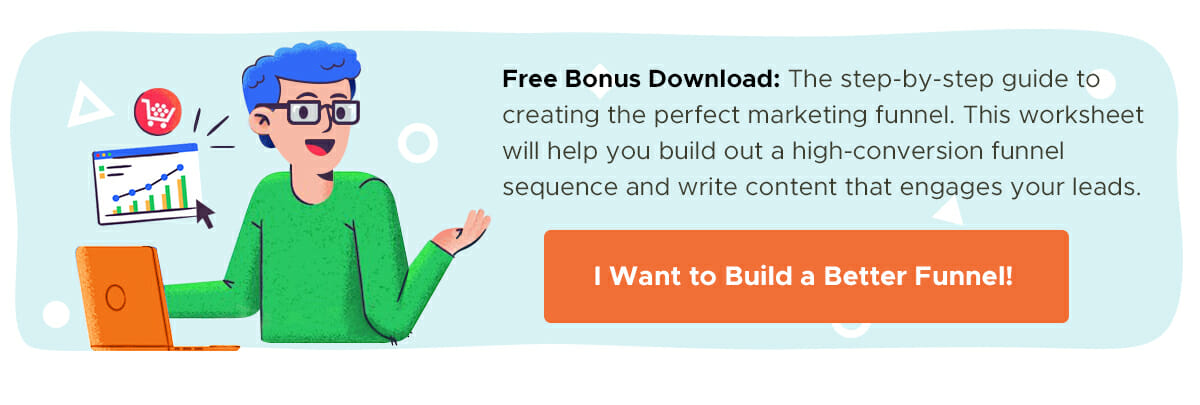NOW UPDATED! This post was updated with new information about retargeting your prospects. Enjoy!
It goes without saying that your marketing funnel — the process that guides someone from stranger to customer — is one of the most important assets your entire marketing department has.
But if you want to take the conversions you’re getting through marketing to the next level, your funnel needs to include some form of retargeting: monitoring your customer’s behavior and using that info to push them back to your site.
Retargeting is an excellent way to supercharge your marketing ROI, but it’s not as easy to implement as you might think. You’ll need some guidance to keep you on the right side of your audience’s mind — especially with 80% of Internet users admitting to having concerns about their privacy.
In this guide, we’ll explain exactly what retargeting is and the (non-creepy) techniques you can use to push people through the purchasing process.
What Is Retargeting?
Have you ever visited a website and then later started seeing banners for that website following you around all over the web? That’s retargeting — aka remarketing (people use those words interchangeably).
Retargeting happens when you visit a website (like Amazon) and they put a cookie on your computer. No matter where you go on the web, they will identify you — meaning that they can show you ads related to the web pages you visited when clicked on Amazon’s website.
When retargeting was first introduced, specialized platforms like AdRoll would be the route to making retargeting possible:
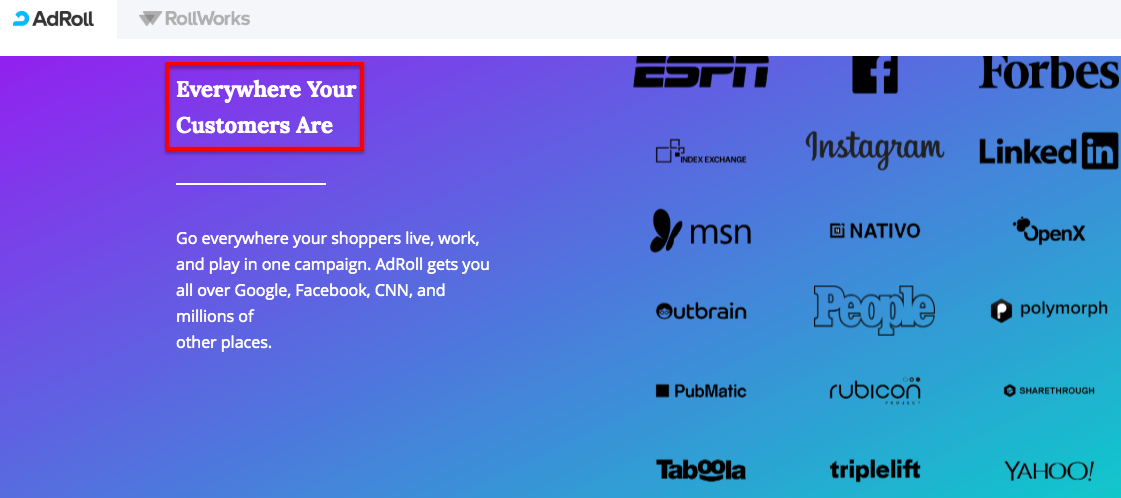
However, companies like Facebook, Google and Twitter now offer retargeting options, allowing you to retarget people directly from their platform.
GDPR and Retargeting
“Does retargeting go against privacy laws?” This is a great question to ask.
The short answer is no — so long as your website has a clear privacy policy that mentions how you collect and use visitor data, including cookies:

Dive Deeper:
- How to Easily Set Up a High-Conversion Facebook Retargeting Campaign
- The Email Marketer’s 4-Step Guide to GDPR Compliance
- How to Get 1,000 True Fans with Facebook Video Retargeting
The Benefits of Using Retargeting for Marketing
Chances are, your marketing funnel is built to drive brand awareness and increase conversions.
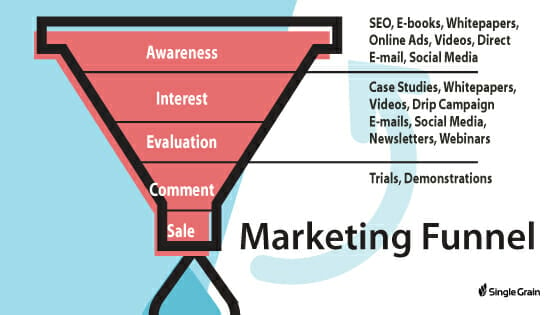
Retargeting can assist both, purely because you have the space to create direct, unique and personalized ads — in other words, the ads that will produce the high click-through rates and ROI you’re dreaming of.
Don’t believe me? Consider these retargeting statistics:
- 3 out of 4 customers notice retargeted ads
- Retargeted ads on Facebook are 76% more likely to get clicks than regular display ads
- If you leverage retargeting along with other channels, you can sell 50% more
If that’s not enough to convince you to add retargeting into the mix, I don’t know what is.
Let’s say that you have a marketing site and a visitor clicks on a link to your SEO services page. They’re going to be placed on your SEO retargeting list, meaning that they’ll receive emails containing SEO-related content since that’s what they’ve demonstrated an interest in:

Although the standard funnel can be effective, it’s impersonal. You have to use one-size-fits-all messaging for your funnel — which is why retargeting can be an even better strategy than creating a funnel to segment visitors into email lists.
In the past, marketers had no option but to create their own marketing strategies based on audience analytics and market research. But thanks to the power of retargeting, you can now continue the conversation without the need of an email or phone number from the potential lead.
Target a Specific Audience and Deliver Tailored Value
Retargeting also opens your marketing department up to a variety of other campaigns.
It’s not as simple as “Well, if they hit a product page, I’m just gonna follow them around with that banner.” That might be standard for a lot of e-commerce sites, but it’s not optimized for the people lingering within the funnel.
Let’s go back to our marketing agency example and put that into practice. If a website visitor reads one of your blog posts and the topic was about creating a marketing funnel, you can follow them around on the Internet — and perhaps offer a free marketing funnel e-book in the form of a display ad.
Then, once they opt in through the e-book, they’re placed onto another pixel on Facebook. Facebook knows these people have opted in for the e-book (probably a warm lead), so the next step might be to catch them with a webinar or get them to buy a product.
What happens then? The lead in question filters through the funnel.
Push Leads Through the Funnel Faster
The idea behind any marketing funnel is to move people down through the various stages, right? If you know they usually purchase after five touches with your brand, try to see if you can cut that down to two or three with the addition of retargeting.
Research has shown that 92% of customers don’t purchase on their first visit to a website — which is why you need to follow them around and make sure they enter back into the funnel at the right stage. In order to do that, you’ll need to retarget them with fresh content.
If someone comes to your homepage and they don’t convert, when you do a remarketing campaign, do you think you should send them back to your homepage? No! They obviously didn’t resonate with the content there, so try to nudge them back onto your website with something new.
Remember: Retargeting Is Like Dating
If you go up to a random person and ask “Will you marry me?” chances are, they’re going to say no…. And possibly hit you.
But if you ask that same random person “Hey, I think you’re cute, would you like to go on a coffee date?” they might say yes. The coffee date goes well, you guys go on a few more dates, get serious, eventually move in together, and finally someone pops the question. At this point, there’s a much higher chance that they’ll say yes when you ask them to marry you.
As with dating, the key to remarketing is building relationships and trust.
Someone comes to your website, they don’t buy, you remarket to them, and they keep seeing your ads everywhere. They feel like they know you — and thus are more likely to give you a chance than a total stranger.
But the rules of remarketing work both ways. Just as you don’t want to push them towards a conversion after one website visit, you’ll need to be wary about the number of ads you’re using to retarget them. You don’t want them to think you’re a stalker.
By the way, the “rule of seven” works well with remarketing, too:
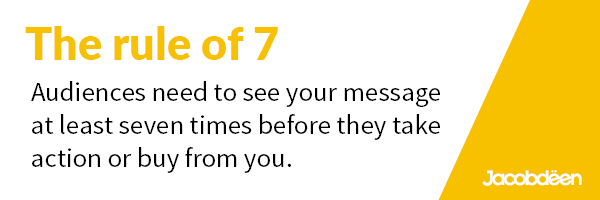
The aim of remarketing is to earn your site visitors and potential customers’ trust by making them comfortable with you. Then you gently push to get them back to your site by educating them further through blog posts, webinars, training materials and email follow-up sequences. Finally, you “pop the question” – ask them to make a purchase.
Your audience is much more likely to convert if they’ve already invested in trusting you.
How to Retarget People in 4 Key Stages of the Marketing Funnel
Are you ready to harness the power of retargeting and start driving people back to your website — no matter what stage of the marketing funnel they’re lingering in?
It’s time to group your entire audience into three stages – cold, warm, and hot – depending on how likely they are to convert:
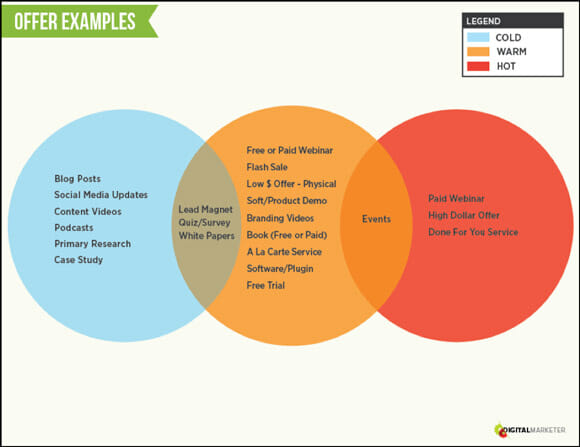
Here’s how you can target them with retargeting throughout each stage:
1) Cold Traffic (Awareness)
People who’ve never heard of your brand before and have never engaged with your content before visiting your site are classed as cold traffic. They’re basically the “newbies” of website visitors.
It’s notoriously hard for a marketing team to convert someone at this stage because they don’t have any connection with your brand. They’re just in the awareness stage of the marketing funnel: searching for information without the intent to hit “buy”. But that doesn’t mean you can’t nurture them through retargeting.
For example: If a first-time visitor lands on your blog post, include links to your “About” page to convince them to learn a little bit about you. Give them tons of free value from your blog post and include a content gift (i.e. a lead magnet) to collect their email address — such as a webinar, an e-book, a case study or a video training.
You can use their email address for remarketing through Facebook ads. Simply upload a custom list of the email addresses who have downloaded your lead magnet and create an advertising campaign targeting that specific group of people. (You can do this both on Google and Facebook’s advertising platforms.)
But what happens if your blog post audience doesn’t download your upgrades? Don’t panic — you can pixel them for future retargeting. Taking the same example of a blog post, pixeling your reader means that you’re able to retarget them on Google and Facebook:
![]()
Use your remarketing ads direct people in this “cold” traffic stage towards content geared for “warm” traffic — such as webinars, case studies or white papers. That way, they’re moving along the conveyor belt towards a purchase.
Dive Deeper:
- Here’s How Targeting Cold, Warm & Hot Traffic Builds Successful Customer Relationships
- How to Create A High-Value Lead Magnet to Quickly Grow Your Email List
- How E-commerce Companies Can Boost Sales with Facebook Ads
2) Warm Traffic (Interest)
If we think of retargeting as finding ways to maintain and sustain product interest, then retargeting ads can be implemented throughout the entire marketing funnel.
The next stage of the funnel is “warm traffic” — the group of people lingering in the interest stage as they continue to research which products or services can solve the problem they’re facing.
Here are few retargeting ideas you can run at this stage:
- Gather a list of products they have clicked on in your site, and use Facebook’s product carousel ad format to display them again:
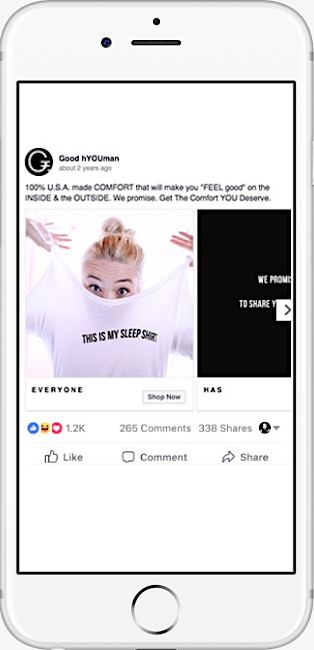
- If you have the email address of your lead (through a content upgrade they’ve already downloaded), send them links to products related to the blog post they clicked in a previous email. For example, if they clicked a blog post titled “How to Do SEO”, point them in the direction of your SEO services page.
- Offer even more free content, such as another e-book or white paper, that’s relevant to the blog posts they’ve already viewed — especially if you’re in B2B. 78% of B2B buyers admit to consuming three or more pieces of relevant content before talking to a salesperson.
Remember: Giving something of value for free is superb tactic to retarget warm traffic, as long as it’s specific to what they seem to be looking for when they visit your site.
3) Hot Traffic (Evaluation and Purchase)
People considered to be “hot traffic” are coming towards their final decision. They’re actively looking to purchase a product or service that solves their pain points. So you need to make sure that you’re in their mind when they’re making that decision.
Hot leads in the evaluation and purchase stages of the funnel want to overcome objections. If you’re offering rideshare services, those objections/questions might be:
- How do I pay?
- Can I pay with my mobile?
- Does your system accept MasterCard?
You can find the questions that your audience is asking by doing customer research. Survey your previous customers and ask them what their concerns were before they made the purchase. You can use their answers to fill out your buyer personas, along with answering common queries with remarketing ads.
Using the rideshare example, you can answer customer concerns by running Facebook ads to the group of people (using custom audience lists) with the headline “Add your MasterCard and ride instantly”.
Remember that when you’re retargeting people in this stage of the marketing funnel, urgency is key. Give them a reason to purchase your product or service now (rather than later) using discounts, offers and time-sensitive promotions.
Research shows that 97% of consumers look for deals when they shop, and 92% said they’re always looking, so why not help potential customers cut right to the chase:
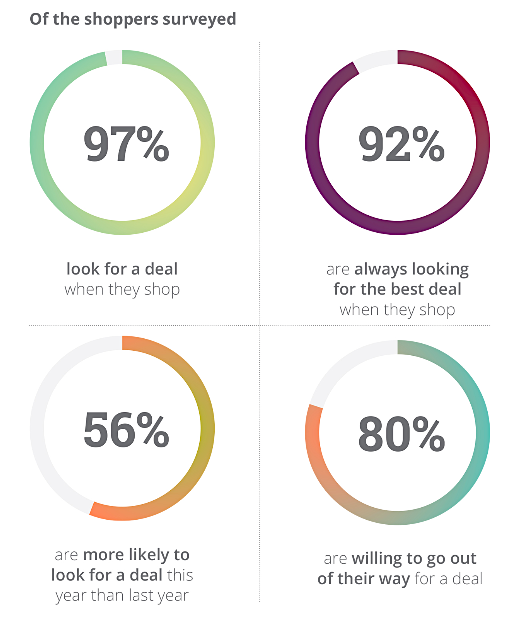
Dive Deeper: Attract the Right Prospects With Buyer Personas (Includes Step-by-Step Templates!)
4) Post-Sale: Going the Extra Mile
Great job! You’ve nurtured your customer throughout each stage of the marketing funnel, and they’ve made their way onto your customer list. Your retargeting job isn’t over yet, though.
You’re able to use your buyers’ list, containing everybody who has already purchased from your brand, to retarget them again — and hit them with higher ticket offers to encourage repeat purchases.
Let’s say a buyer bought something from you for $500. Maybe the next upsell is $5,000. And then after that, maybe it’s $50,000. By retargeting them through ads on Facebook and Google, you can bring them further and further down through your funnel.
Show them products they’ve purchased before or new items that could support the product they’ve just bought. For instance, if your customer has recently purchased a new laptop, why not run retargeting campaigns that show screen cleaning wipes, wireless mice or spare chargers?
More importantly, this strategy helps to increase your CLV (customer lifetime value) by encouraging them to convert time and time again:
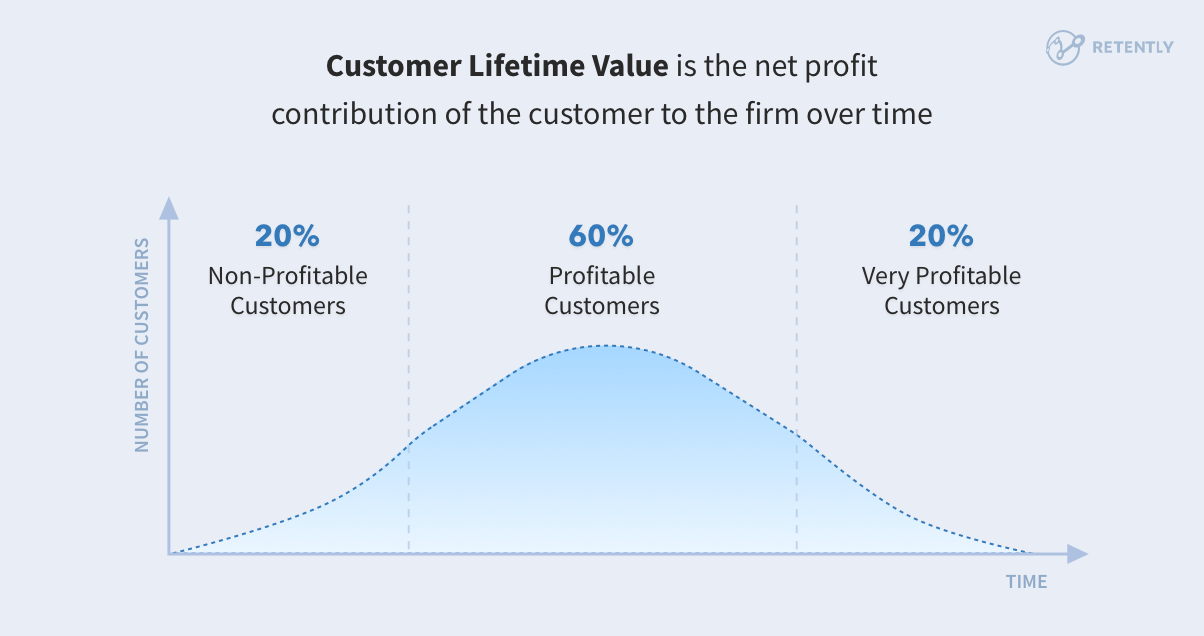
That’s a great way to get long-term ROI from your advertising campaigns.
Bonus: Find New Customers with Retargeting Audiences
The best part about remarketing? You’re able to do a lot more with those pixels than simple advertising campaigns.
With Google, you can build smart audiences, or lookalike audiences, from people who have visited specific sections.
Same thing with Facebook’s lookalike segments feature — a technique you can use to say “Hey Facebook, go and find people on Facebook that have similar interests to these people who’ve visited a specific section on my site.”
Facebook’s algorithms will build an audience based on 1% lookalikes, which is usually around 2-2.5 million people:
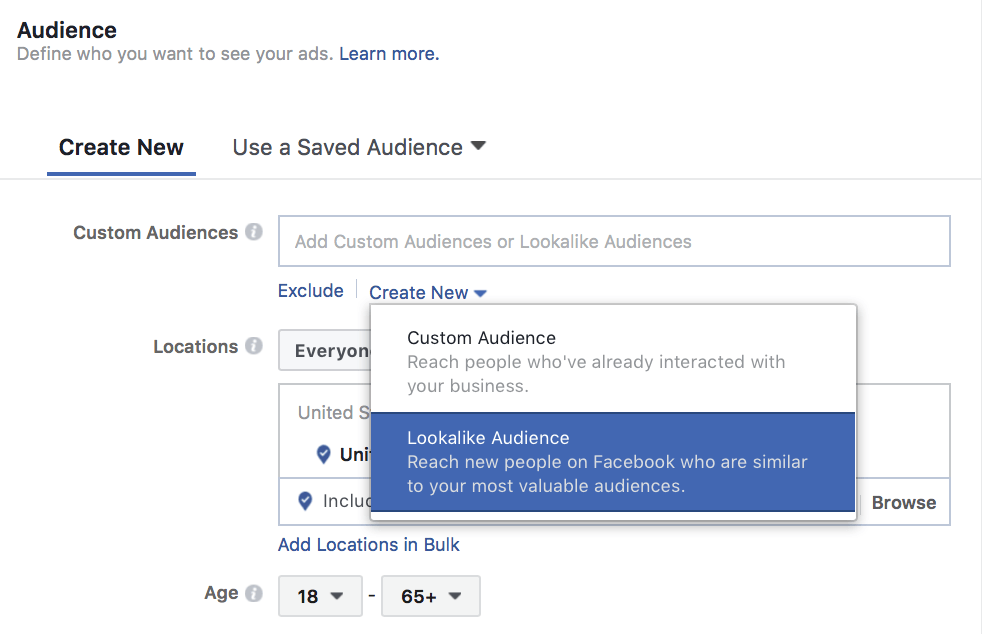
This lookalike audience contains people who match your previous customers. They have the same purchasing behaviors, Internet habits and buying preferences — making them the ideal audience to start pushing towards your marketing funnel.
It’s a never-ending source of new potential leads. The process continues over and over again.
Learn More:
- 7 Slick Ways to Get a Hold of Your Leads Through Marketing
- 8 Facebook Ad Copywriting Tricks to Maximize Conversions
- MQL vs. SQL – Serve Up The Right Type Of Content To Your Leads
When Is Retargeting a Bad Idea?
Keep in mind that too much of something can be a bad thing (and we’re not just talking about chocolate cake!).
Case in point: Our digital marketing agency doesn’t generate too many sales from South America. And while our South American audience accounts for a good amount of our website traffic, we’re not remarketing to them because that money would be better spent elsewhere.
You might be asking why, especially because the remarketing traffic costs for South America are way more affordable than remarketing costs for the U.S., UK, Canada and Australia, for example. Well, if we already know that this group of people isn’t very likely to convert into sales, why spend any time retargeting them in the first place?
The same applies if, say, you have a coffee shop in Seattle. Why would you remarket to people in California? By doing that, you’re just going to get a ton of people going to your website who won’t ever buy anything or stop at your coffee shop. You’ll need to be aware of “over targeting” your audience.
Retargeting is about staying on the minds of your target customers — and that’s unlikely to be everyone visiting your website.
Outsourcing: Remarketing vs. In-House Campaigns
You can use the AdRolls of the world, but they don’t have the inventory of Google or Facebook.
That’s why our CEO, Eric Sui, says:
“I would just use Google and Facebook. They’re going to be the majority of your impressions, inventory clicks and traffic. When you’ve mastered Google and Facebook, then you can start talking to the AdRoll-type of companies.”
Be careful on your quest to outsource, though. When you talk with the reps, they make it sound like it’s all sunshine and rainbows: “Oh, wow. Your cost per acquisition is amazing. It’s $5 and you told us your target was $50.” That has to be amazing, right?
But here’s the thing: When agencies are giving you those numbers, they’re looking at the “view through conversion” metric. That’s somebody who saw your banner but didn’t directly convert. They may have gone back to your website at a later date for a totally different reason, but the rep will still count that as a conversion.
At the end of the day, the holy grail metric of remarketing campaigns is ROI.
If you’re spending more cash on an agency to run your campaigns than you’re generating through their ads, cut your ties and bring it in-house.
Dive Deeper: Outsourcing: The Passive Path to Growing Your Business
Final Thoughts on Remarketing
As with all aspects of digital marketing, retargeting is a commitment. It may take a few months to see any ROI — and you’ll probably have to test and tweak your messaging continuously after that.
Always remember that since the audience has somewhat of an awareness of you already, what worked before won’t work the next time. You’ll need to constantly split-test or A/B test to see what resonates with your audience as they pass through the marketing funnel.
The more you know your audience, the better you can retarget them as they work through the marketing funnel. Next thing you know you’ll have customers saying, “It’s almost as if they read my mind and knew exactly what I wanted.” That’s when you know you’re killing the game.
